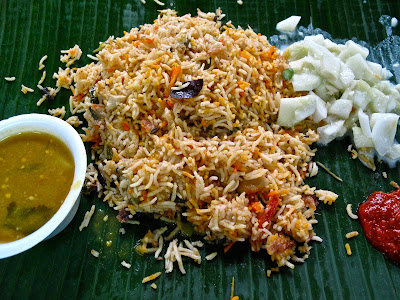 Nasi Briyani or Nasi Biryani is indeed one of local dishes but it has it's origin in India. According to Lizzie Collingham, in her great book on Indian food history -Curry: A Tale of Cooks & Conquerors, she mentions that this pinnacle of Mughlai cuisine originated in Delhi and the credit goes to Humuyan, the great 2nd Mughal emperor. He was in Iran for a brief period as a refugee and was amazed with Persian culture including cuisine. When he eventually came back to India, he brought with him, great Persian cooks along. Briyani is a spiced-up version of Pilau where the dish originated in Persia. In Persia, where the staple is wheat, rice was considered a luxury item and therefore, pilau rice is a rice dish where greatest emphasis was put on rice -very irregular considering rice as a food staple elsewhere. Pilau eventually transforms into variety of dishes around the globe -pilav in Turkey, pilaf elswhere, risotto in Italy, paella in Spain. One thing to note is that, nasi briyani is not strictly New Delhi type but southern Indian (especially Hyderabad). The Mughal empire spread south to Hyderabad and so did briyani method of cooking but with south Indian flavors using "curry leaves, more chilies, tamarind and coconut" (Collingham, Lizzie, Curry (Oxford University Press, 2006, New York). However, though nasi briyani has a southern influence in Singapore, currently it comes in variety of forms hence quite difficult to precisely codify this dish. Unique that nasi briyani comes on a banana leaf which is highly unusual in India. Whether dum or not, nasi briyani is a league on its own.
Nasi Briyani or Nasi Biryani is indeed one of local dishes but it has it's origin in India. According to Lizzie Collingham, in her great book on Indian food history -Curry: A Tale of Cooks & Conquerors, she mentions that this pinnacle of Mughlai cuisine originated in Delhi and the credit goes to Humuyan, the great 2nd Mughal emperor. He was in Iran for a brief period as a refugee and was amazed with Persian culture including cuisine. When he eventually came back to India, he brought with him, great Persian cooks along. Briyani is a spiced-up version of Pilau where the dish originated in Persia. In Persia, where the staple is wheat, rice was considered a luxury item and therefore, pilau rice is a rice dish where greatest emphasis was put on rice -very irregular considering rice as a food staple elsewhere. Pilau eventually transforms into variety of dishes around the globe -pilav in Turkey, pilaf elswhere, risotto in Italy, paella in Spain. One thing to note is that, nasi briyani is not strictly New Delhi type but southern Indian (especially Hyderabad). The Mughal empire spread south to Hyderabad and so did briyani method of cooking but with south Indian flavors using "curry leaves, more chilies, tamarind and coconut" (Collingham, Lizzie, Curry (Oxford University Press, 2006, New York). However, though nasi briyani has a southern influence in Singapore, currently it comes in variety of forms hence quite difficult to precisely codify this dish. Unique that nasi briyani comes on a banana leaf which is highly unusual in India. Whether dum or not, nasi briyani is a league on its own.ナシビリヤニ(ブリヤニ)はシンガポール料理として定着しているが、そもそもビリヤニはインド料理である。そして歴史を更にさかのぼると、ビリヤニとはムガル料理でインドのデリーで発案されたものだ(Curry: A Tale of Cooks & Conquerors by Lizzie Collingham)。ムガル料理は歴史的背景から特にペルシャ料理の影響を強く受けている。1550年頃、ペルシャに長くいたフマーユーン皇帝(Humuyan)が多くのペルシャ料理人と一緒にインドへ戻ってきたのだ。ペルシャ料理の中で最も素晴らしいとされていたのがピラウ(pilau)という料理だ。ピラウ(又はプラオ)は主に小麦等が主流のペルシャでは特別な料理でライスは高級品だ。そのお米を使って作るプラウは料理の脇役ではなく、料理の主役だ。ビリヤニとプラウ、調理方法は大きく変わらないがムガル系の料理はスパイスを多く使い、ペルシャ料理はそれにくらべてデリケートな味付けとなっている。ただ、シンガポールのナシビリヤニは南インドのハイデラバード系の影響を受けている。1600年代初期、ムガル料理は南へと下りビリヤニは南系の食材である、カレーリーフ、唐辛子、タマリンドそしてココナッツを取り入れる事となる。普通オーソドックスなビリヤニがバナナリーフと一緒に提供される事はないのだが、シンガポールでは南系の影響を受けているのでそれも存在する。イスラム系の多いタイの南では、ナシビリヤニをカオモックガイ(直訳するとライス・イン・チキン)として売っている、れっきとしたタイ料理だ(写真下)。カオモックガイはタイのナシビリヤニだが、ライスがココナッツミルクとカレー粉で炊かれている。トッピングに揚げネギとパクチーだが非常に旨い。このお店ではスィートチリソースが付いてきた。

0 件のコメント:
コメントを投稿